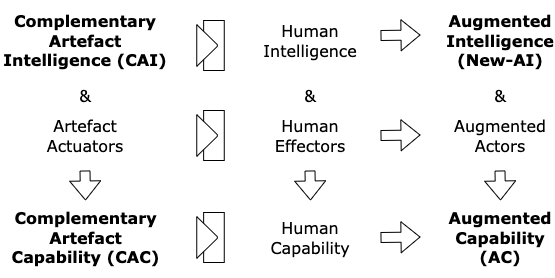Roger Clarke's Web-Site
© Xamax Consultancy Pty Ltd, 1995-2024

Infrastructure
& Privacy
Matilda
Roger Clarke's Web-Site© Xamax Consultancy Pty Ltd, 1995-2024 |

|
|||||
| HOME | eBusiness |
Information Infrastructure |
Dataveillance & Privacy |
Identity Matters | Other Topics | |
| What's New |
Waltzing Matilda | Advanced Site-Search | ||||
Version of 27 December 2022
© Xamax Consultancy Pty Ltd, 2022
Available under an AEShareNet ![]() licence or a Creative
Commons
licence or a Creative
Commons  licence.
licence.
This document is at http://rogerclarke.com/EC /AITS-Summ.html
This is an edited extract from the following article:
Clarke R. (2023) ' The Re-Conception of AI: Beyond Artificial, and Beyond Intelligence' Forthcoming, IEEE Transactions on Technology & Society 4,1 (March 2023), PrePrint at http://www.rogerclarke.com/EC/AITS.html
Its purpose is to explain the proposal the article contains. For the background analysis of 'Old-AI', what's wrong with the idea and its impacts, and why re-conception is essential, see the article.
The original conception of artificial intelligence ('Old-AI') was as a simulation of human intelligence. That has proven to be an ill-judged quest. In addition to leading too many researchers repetitively down too many blind alleys, the idea embodies far too many threats to individuals, societies and economies. The world needs an alternative way of seeing and doing 'smart' systems, to enable both the achievement of positive outcomes and the prevention, control and mitigation of harmful impacts. To increase value and reduce harm, it is necessary to re-conceptualise the field.
A starting-point is recognition of the fact that there are already 8 billion humans. So society gains very little by creating artefacts that think like humans. The idea of 'artificial' intelligence was mis-directed, and has resulted in a great deal of wasted effort during the last 70 years. We don't want 'artificial'; we want real. We don't want more intelligence of a human kind; we want artefacts to contribute to our intellectual endeavours. Useful intelligence in an artefact, rather than being like human intelligence, needs to be not like it, and instead constructively different from it. One useful redefinition of 'AI' would be as 'Artefact Intelligence', putting the focus on a manufactured entity in which some form of intelligence exists, rather than on the nature of the intelligence.
The valuable form is usefully called 'Complementary Artefact
Intelligence' (CAC).
Its characteristics are:
Other ways of expressing the difference between Old-AI and CAC are that it embodies a shift from emulating humans to empowering people, and that it extends humans' abilities. The focus is on the design of artefacts to provide decision support rather than to make decisions.
However, we need to lift our ambitions higher than Artefact Intelligence. Our focus needs to be on devising Artefact Intelligence to combine with Human Intelligence to deliver something superior to each of them. The appropriate term for this construct is 'Augmented Intelligence' (New-AI). The idea has a long and to some extent cumulative history, dating back to the 1950s and 1960s. The following working definition is proposed:
Augmented Intelligence (New-AI) is the integration of Human Intelligence and Complementary Artefact Intelligence into a whole that is different from, and superior to, either working alone
Some of the ideas advanced in these areas adopt the assumption that artefact
capabilities will shortly exceed human capabilities, and that humans should be
treated as secondary participants in technical systems. In some contexts, such
as control systems for high-speed operations in factories and transportation,
and largely autonomous 'moon-buggies', that idea makes sense.
On the other
hand, in the large majority of circumstances in which artefacts play a role,
human activities are crucial, and a socio-technical rather than a technical
approach is essential. The notion of a robot-managed world continues to be
science fiction. The focus needs to be on artefacts as tools to support
humans. Humans of the 21st century want 'Humans+', but by federating with
artefacts rather than by uniting with them, or by becoming them, or by them
becoming us.
Re-conception of the 'A' in AI from Artificiality to Augmentation is alone capable of delivering great benefits. It redirects the focus of product designers and application developers from artefacts, to artefacts functioning within a broader context containing people. It demands underlying techniques that support designs for socio-technical systems, within which artefacts must embody intellectual capabilities that are distinct from those of people, and complementary to them. Attention must also be paid to the effectiveness and efficiency of interactions between the people and the artefacts.
The risk remains that designers will think only of the humans who directly interact with the artefact ('users'), and will overlook the interests of others who are affected by the operation of the socio-technical system ('usees'). Nonetheless, re-discovery of technology-in-use as the proper concern of design is an important step forward.
Beyond Augmented Intelligence, a further step remains, that extends beyond the intellectual realm. Inferences and decisions give rise to actions. Humans act through effectors like arms and fingers. Artefacts, in order to act in the world, are designed to include actuators such as robotic arms that exert force on real-world phenomena. In the same way that Artefact Intelligence is most valuable when it is designed to complement Human Intelligence, Artefact Actuators can be developed with the aim in mind to complement Human Effectors, resulting in Augmented Actors comprising a compound of humans and machines.
The capability of action arises from the combination of the intellectual and
the physical.
Human Capability arose not merely from the
ability to oppose forefinger and thumb, but also from the intellectual
realisation that something useful can be done with things held between the two
body-parts.
Similarly, artefacts' direct real-world impacts depend on the combination of Artefact Intelligence with suitable Actuators. The final part of the re-conception is to recognise the significance of Complementary Artefact Capability (CAC) that dovetails with Human Capability, resulting in a powerful form of synergy. By coordinating the intellectual plus the physical characteristics, of both humans and artefacts, we can achieve a combined capability of action superior to that which either human or artefact can achieve alone. This is usefully described as Augmented Capability (AC).
Here is a visual depiction of the proposed re-conception of the field:

I contend that the implications of this re-conception are profound, and extend across the entire value-chain from the laboratory to deployment in the field. The notion of humanlike or human-equivalent intelligence (Old-AI) is a dangerous distraction. The focus must be on artefacts as tools, and on the delivery of purpose-designed artefact behaviour that dovetails with human behaviour to achieve real-world objectives. The new-AI and Augmented Capability notions can quickly lead us towards appropriate ways to apply technologies while managing the potentially enormous threats that they harbour for individuals, economies and societies.
Roger Clarke is Principal of Xamax Consultancy Pty Ltd, Canberra. He is also a Visiting Professor associated with the Allens Hub for Technology, Law and Innovation in UNSW Law, and a Visiting Professor in the Research School of Computer Science at the Australian National University.
| Personalia |
Photographs Presentations Videos |
Access Statistics |
 |
The content and infrastructure for these community service pages are provided by Roger Clarke through his consultancy company, Xamax. From the site's beginnings in August 1994 until February 2009, the infrastructure was provided by the Australian National University. During that time, the site accumulated close to 30 million hits. It passed 65 million in early 2021. Sponsored by the Gallery, Bunhybee Grasslands, the extended Clarke Family, Knights of the Spatchcock and their drummer |
Xamax Consultancy Pty Ltd ACN: 002 360 456 78 Sidaway St, Chapman ACT 2611 AUSTRALIA Tel: +61 2 6288 6916 |
Created: 20 March 2022 - Last Amended: 27 December 2022 by Roger Clarke - Site Last Verified: 15 February 2009
This document is at www.rogerclarke.com/EC/AITS-Summ.html
Mail to Webmaster - © Xamax Consultancy Pty Ltd, 1995-2022 - Privacy Policy